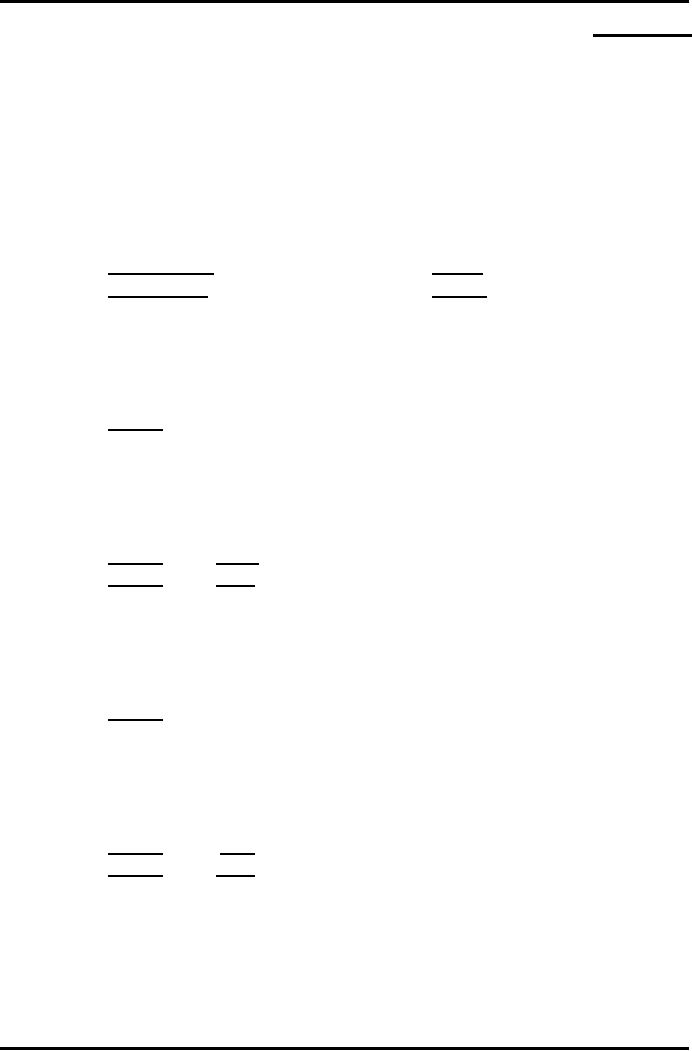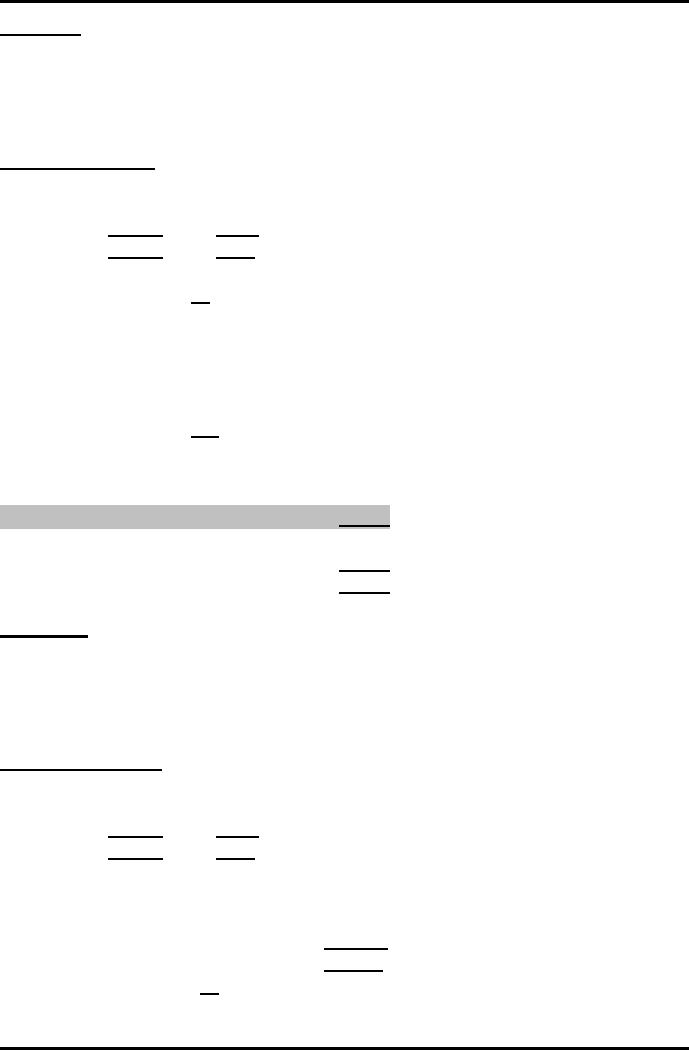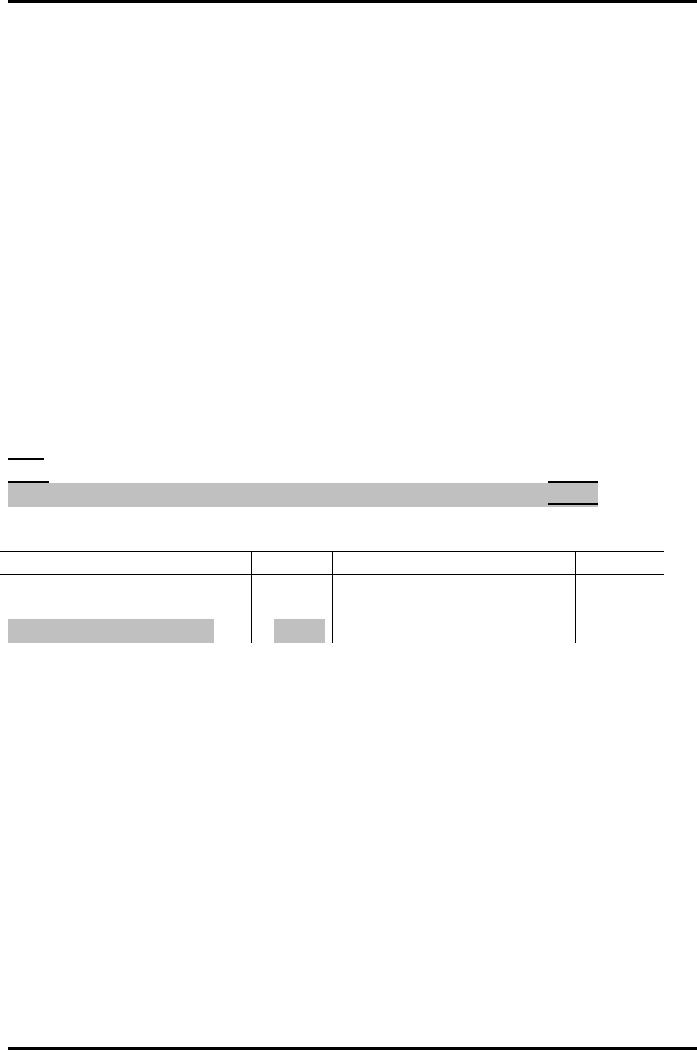 |
SINGLE ENTRY CALCULATION OF MARKUP AND MARGIN |
| << SINGLE ENTRY CALCULATION OF MISSING INFORMATION |
| ACCOUNTING SYSTEM IN NON-PROFIT ORGANIZATIONS >> |

Advance
Financial Accounting
(FIN-611)
VU
LESSON
# 5
SINGLE
ENTRY
CALCULATION
OF MARKUP AND MARGIN
Cost
Structure
Cost
structure stands for the
percentage structure of Sales Revenue,
Cost of Goods
Sold
and Gross profit. Through cost
structure percentage of gross
profit is determined
over
the cost of goods sold and
over the sales revenue. It
can be expressed in
equation
like
this:
Sales
Revenue
Sales
Less
Cost
of Goods Sold
or
COGS
GP
Gross
profit
Markup
rate
Markup
rate is the rate of gross
profit over the cost of
goods sold, it is expressed
in
%age
and it is formulated like
this:
G P
x100 = %
COGS
In
calculating markup rate the
cost of goods sold is kept
equal to 100%. Suppose
the
markup
rate is 25% then the cost
structure in markup will be like
this:
Sales
125%
COGS
100%
GP
25%
Margin
rate
Margin
rate is the rate of gross
profit over the sales
revenue, it is expressed in
%age
and it is
formulated like this:
G P
x100 = %
Sales
In
calculating margin rate the
sales revenue is kept equal
to 100%. Suppose the
margin
rate
is 25% then the cost
structure in markup will be like
this:
Sales
100%
COGS
75%
25%
GP
These
markup/margin rates are used in
calculating gross profit or
cost of goods sold
or
even sales, it will all depend upon
the scenario. For
example:
19

Advance
Financial Accounting
(FIN-611)
VU
Scenario
I
Sales
Rs. 80,000
Purchases
(to be found)
Opening
Stock Rs. 6,000
Closing
Stock Rs. 2,000
Whereas
goods are sold at a markup of
25%
Solution
Scenario I
The
cost structure is like
this:
Sales
125%
COGS
100%
GP
25%
Gross
Profit = 80,000 x 25 = 16,000
125
Cost
of goods sold = Sales Gross
profit
=
80,000 16,000
=
64,000
Direct
calculation of Cost of goods
sold
= 80,000 x 100 =
64,000
125
Rs.
Opening
Stock (given)
=
6,000
Purchases
(balancing figure)
=
60,000
Cost
available for sale
=
66,000
Closing
Stock (given)
=
2,000
Cost
of goods sold
(calculated)
=
64,000
Scenario
II
Sales
(to be found)
Purchases
Rs. 155,000
Opening
Stock Rs. 10,000
Closing
Stock Rs. 15,000
Whereas
goods are sold at a margin
of 25%
Solution
Scenario II
The
cost structure is like
this:
Sales
100%
COGS
75%
GP
25%
Cost
of goods sold =
Opening
stock 10,000
Purchases
155,000
Closing
stock 15,000
150,000
Gross
Profit = 150,000 x 25 = 50,000
75
Sales =
Cost of goods sold + Gross
profit
20

Advance
Financial Accounting
(FIN-611)
VU
= 150,000 +
50,000
=
200,000
Direct
calculation of Sales
=150,000
x 100 = 200,000
75
ACCOUNTING
FOR NON-PROFIT ORGANIZATIONS
Introduction
Accounting
is a language to communicate and
understand financial
information,
every
organization, whether involve in business
or non business activities,
needs
accounting
to get financial
reports.
Non
profit organizations are not
involved in complex transactions
like trading of
goods
or services and manufacturing activities
therefore a very simple
accounting
system
can work.
Mainly
these organizations are
engaged in welfare activities or
the activities that
will
entertain
its members specifically and
others in general. A very commonly
understood
example
of such organizations is mosque or
church. Almost all of us use to
visit our
worship
place frequently and can
understand very easily that it is an
organization
where
we can have examples of
assets, liabilities, incomes and
expenses as well.
But
remember non profit organizations do not
have owner's equity because
these are
not owned by any
one rather a managing
committee looks after all
affairs of the
organization.
Therefore there is no question of
owner's equity in the
financial
information
of non profit organizations.
Accounting
Records
Cash
book is prepared in a chronological
sequence; it is the only book of
original entry
that
is maintained by the accountant of a non
profit organization. At the
end of the
accounting
year a summary of total cash
receipts and total cash
payments is made
under
different heads, such summary is known as
Receipt and Payment
Account.
Cash
book will contain subscription
received on different dates during
the year where
as
the Receipt and Payment
Account will contain a single amount of
total subscription
received
during the year. Similarly
cash book contains payment
of salaries made on
different
dates of the year, whereas,
the Receipt and Payment
Account will show the
total
salaries paid during the
year as a single
information.
Memorandum
Records
A non
profit organization that has
a large number of members will also
maintain a
memorandum
record of members, and if that
organization is running activities
like
providing
medicines or providing library
facilities or running a sports club then
it will
also
be maintaining memorandum record for
the inventory items.
Financial
Statements
Non
profit organizations prepare
Income
and Expenditure Account
that
replaces
Income
Statement of a business concerns to
obtain surplus (excess of
incomes over the
expenses)
or deficit (excess of expenses
over the incomes).
Incomes
of a non profit
organization
Incomes
of a non profit organization mainly
include the
following:
21

Advance
Financial Accounting
(FIN-611)
VU
o Subscription
o Donation
o Entrance
fee
o Lockers
rent
o Membership
fee etc. etc.
All
these incomes are measured
according to the accrual
concept. Actual receipts
of
these
incomes are recorded in the
Cash Book and ultimately
become part of the
Receipt
and Payment account. Such
receipts are then adjusted with
the opening and
closing
owing/advance income to get
the balance of income that
belongs to the
current
accounting period.
For
example:
Rs.
55,000 subscription received during the
year ending on December 31
20x7 of which
Rs
5,000 relate to the
subscription due in the year
20x6 and Rs. 2,000 was
received in
advance
that was relating to the
year 20x8. Rs. 3,000
subscription of few members
was
received
in advance during the year
20x6 and Rs. 4,000
subscription relating to
the
year
20x7 is still due to be
received.
Rupees
Cash
received during the year
20x7
55,000
Less
Cash received not related to
year 20x7 (5,000 +
2,000)
7,000
Add
Income relating to the year
20x7 (3,000 + 7,000)
10,000
Subscription
income for the year
20x7
58,000
Subscription
(Income) Account
Debit
Rupees
Credit
Rupees
Opening
Due
5,000
Opening Advance
3,000
Closing
Advance
2,000
Cash Received
55,000
Income
(balancing figure)
58,000
Closing Due
7,000
Expenses
of a non profit
organization
Expenses
are also measured according
to the accrual concept. All
revenue
expenditures
appearing in the payment
side of the Cash Book
(Receipt and Payment
Account)
are adjusted with the
opening and closing balances of
outstanding and
prepaid
expenses. This process of
adjustment converts the
revenue payments in
expenses.
Such expenses are ultimately
matched with the Incomes to
calculate
surplus/deficit.
Balance
Sheet is
prepared to know the financial
position in the same way as
we
already
have studied for business
entities. The only difference in the
balance sheet of a
non
profit organization comparing with
the balance sheet of a
business entity is
that
there
will be no owner's equity instead
there will be a balance of accumulated
fund
also
known as capital fund in the balance
sheet of a non profit organization as a
main
source
of finance.
Accumulated
Fund
Like
owner's equity, accumulated fund is
also a difference of Assets and
Liabilities.
22

Advance
Financial Accounting
(FIN-611)
VU
Accumulated
Fund = Assets
Liabilities
Accumulated
fund represents the funds that
are the source of the
Assets obtained or
constructed
for the organization. These funds
consist of grants, donations,
legacies,
entry
fees, life membership fees
etc.
Often in
the examination questions
Statement of Affairs is prepared to
find the opening
balance
of
accumulated fund.
Practice
Questions
Q.
1
Following
balances were disclosed by
the books of Ali Shah
Traders where the
books
of
accounts were maintained on
single entry accounting
system:
31.12
2007
31.12.2008
Rupees
Rupees
Cash
at Bank
3,000
19,100
Cash
in hand
400
850
Stocks
22,000
25,000
Debtors
?
35,000
Creditors
23,400
18,500
Fixtures
and fittings
2,000
Motor
Car
1,000
Cash
Book analysis showed
following figures amongst
others:
Rupees
Rupees
Receipts
from customers 135,000
Motor
car repair
1,350
Discount
allowed
1,400
Printing
and stationery
800
Fresh
capital on 1.7.2008
2,000
Drawings
6,600
Salaries
upto 30.11.2008
11,000
Payments
to creditors
112,000
Office
rent upto 30.11.2008
2,200
Discount
received
1,200
Advertising
900
Electricity
charges
1,000
General
expenses
600
No
ready figures are available
for total sales but Ali Shah
maintains a steady
gross
profit
rate of 25% on sales.
There
were outstanding bills for
electricity Rs. 250,
Advertising Rs. 150, and
printing
Rs.
450. Provide for doubtful debts upto 5%
of the debtors. Motor car and
fixtures are
to be
depreciated by 20% and 10%
respectively.
Prepare
Income Statement for the
year ended 31-12-2008 and
Balance Sheet as on
that
date.
Hints:
1.
Calculate purchases as balancing
figure in creditors
account
2.
Calculate cash sales as
balancing figure in the cash
book
3.
Calculate total sales with
the help of cost
structure
4.
Calculate credit sales by
subtracting cash sales from
the total sales
5.
Calculate opening debtors
balance as balancing figure in
debtors account
6. Calculate
opening capital from the
statement of affairs
23

Advance
Financial Accounting
(FIN-611)
VU
Q2.
Given
below is the receipts and
payments account of Hameed
Amusement Club:
Receipts
and Payments
Account
For
the year ended 31st
December, 2006
Receipts
Rs.
Payments
Rs.
Salary
of secretary
3,600
Balance
Cash
60
Bank
3,000
3,060
Subscription
9,000
Honorarium
450
(including
subscription for
2005
Rs. 150)
Sale
of old furniture on Jan 1,
750
Wages
2,400
2006
Sale
of old newspapers
50
Charities
2,000
Legacies
3,000
Printing
and
300
stationery
Interest
on investments
1,200
Postage
100
(cost
of investment Rs.
20,000)
Endowment
fund receipts
10,000
Rent
and taxes
1,200
Proceeds
of concerts
800
Upkeep
of land
500
Advertisement
in year book
40
Sports
material
2,500
Balance
14,850
27,900
27,900
Current
assets and liabilities as on 31st
December, 2005 and 31st December, 2006
are as
follows:
31.12.2005
31.12.2006
Rs.
Rs.
Subscription
in arrears
200
450
Subscription
in advance
300
600
Furniture
2,000
1,080
Depreciation
was 10% p.a. on the
furniture left after selling a
part of it. It was
decided
that
half of the legacies may be
capitalized.
24

Advance
Financial Accounting
(FIN-611)
VU
Required:
Prepare
income and expenditure account for
the year ending 31st
December, 2006 and
balance
sheet as on that
date.
You
are also required to show
calculations for the loss on
sale of furniture.
Answers
(Excess
of expenditure over income
Rs. 630, Balance Sheet
total Rs. 36,430,
Capital
fund
in the beginning Rs. 24,960,
Loss on sale of furniture
Rs. 50).
25
Table of Contents:
- ACCOUNTING FOR INCOMPLETE RECORDS
- PRACTICING ACCOUNTING FOR INCOMPLETE RECORDS
- CONVERSION OF SINGLE ENTRY IN DOUBLE ENTRY ACCOUNTING SYSTEM
- SINGLE ENTRY CALCULATION OF MISSING INFORMATION
- SINGLE ENTRY CALCULATION OF MARKUP AND MARGIN
- ACCOUNTING SYSTEM IN NON-PROFIT ORGANIZATIONS
- NON-PROFIT ORGANIZATIONS
- PREPARATION OF FINANCIAL STATEMENTS OF NON-PROFIT ORGANIZATIONS FROM INCOMPLETE RECORDS
- DEPARTMENTAL ACCOUNTS 1
- DEPARTMENTAL ACCOUNTS 2
- BRANCH ACCOUNTING SYSTEMS
- BRANCH ACCOUNTING
- BRANCH ACCOUNTING - STOCK AND DEBTOR SYSTEM
- STOCK AND DEBTORS SYSTEM
- INDEPENDENT BRANCH
- BRANCH ACCOUNTING 1
- BRANCH ACCOUNTING 2
- ESSENTIALS OF PARTNERSHIP
- Partnership Accounts Changes in partnership firm
- COMPANY ACCOUNTS 1
- COMPANY ACCOUNTS 2
- Problems Solving
- COMPANY ACCOUNTS
- RETURNS ON FINANCIAL SOURCES
- IASB’S FRAMEWORK
- ELEMENTS OF FINANCIAL STATEMENTS
- EVENTS AFTER THE BALANCE SHEET DATE
- PROVISIONS, CONTINGENT LIABILITIES AND CONTINGENT ASSETS
- ACCOUNTING POLICIES, CHANGES IN ACCOUNTING ESTIMATES AND ERRORS 1
- ACCOUNTING POLICIES, CHANGES IN ACCOUNTING ESTIMATES AND ERRORS 2
- BORROWING COST
- EXCESS OF THE CARRYING AMOUNT OF THE QUALIFYING ASSET OVER RECOVERABLE AMOUNT
- EARNINGS PER SHARE
- Earnings per Share
- DILUTED EARNINGS PER SHARE
- GROUP ACCOUNTS
- Pre-acquisition Reserves
- GROUP ACCOUNTS: Minority Interest
- GROUP ACCOUNTS: Inter Company Trading (P to S)
- GROUP ACCOUNTS: Fair Value Adjustments
- GROUP ACCOUNTS: Pre-acquistion Profits, Dividends
- GROUP ACCOUNTS: Profit & Loss
- GROUP ACCOUNTS: Minority Interest, Inter Co.
- GROUP ACCOUNTS: Inter Co. Trading (when there is unrealized profit)
- Comprehensive Workings in Group Accounts Consolidated Balance Sheet